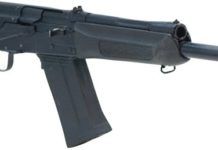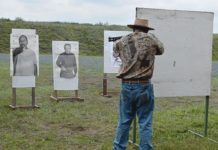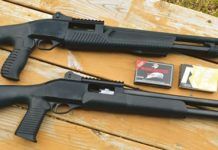[Updated October 4, 2017]
Perhaps due to the “Obama-effect”—wherein the fear of future gun bans is driving sales—the home-defense/tactical class of self-defense shotguns is booming like never before. But we must recognize that other factors figure into the segment’s sales rise as well, not the least of which is that a 12-gauge pump-action shotgun is an effective close-quarters weapon.
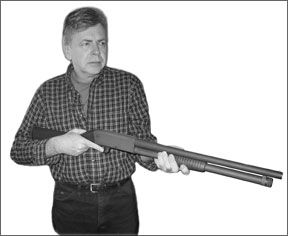
To wit: The M97 version of John Browning’s Winchester 1897 shotgun was the original “trench-sweeper.” Widely considered the first truly successful pump shotgun, the M97 was fitted with a heat shield and the M1917 16-inch bayonet for combat duty. The highly effective use of the shotgun by United States forces in WWI had a dramatic effect on the morale of front-line German troops. As a result, on September 19 of 1918, the German government issued a diplomatic protest against the American use of shotguns, alleging that the law of war prohibited the shotgun. The 5+1 capacity M97 and OO buckshot defined the fast-handling, reliable close-quarters shotgun for about 30 years, the platform of the high-capacity pump persisting through to present day.
The reason to consider a shotgun for personal defense is what many combat studies have shown: the hit probability of a shotgun is roughly twice that of a rifle. For home defense, the shotgun is a quicker stopper than a handgun due to its being able to produce more wound trauma with multiple wound paths. It is considered easier to use in a high-stress situation, and minimizes wall penetration compared to some handgun ammunition. It is also economical to practice with.
Number 1 Buckshot is 30 caliber; it is the superior choice as defined by the International Wound Ballistics Association: “Number 1 buck is the smallest diameter shot that reliably and consistently penetrates more than 12 inches of standard ordnance gelatin when fired at typical shotgun engagement distances. A standard 2-inch 12-gauge shotshell contains 16 pellets of #1 buck. The total combined cross sectional area of the 16 pellets is 1.13 square inches. Compared to the total combined cross sectional area of the nine pellets in a standard #00 (double-aught) buck shotshell (0.77 square inches), the # 1 buck shotshell has the capacity to produce over 30 percent more potentially effective wound trauma. In all shotshell loads, number 1 buckshot produces more effective wound trauma than either #00 or #000 buck. Also, #1 buck is less likely to over-penetrate and exit an attacker’s body.” (For further reading, consult Dr. Martin Fackler and Duncan MacPherson’s works on bullet penetration and wounding ballistics.)
This match-up includes the Ithaca Model 37 Defense Gun ($469), very close to the M37 “Trench Gun” that saw action in WWII and in Vietnam; the Remington Model 870 Tac-2 FS ($692), and the Mossberg 590A1 w/Black Aluminum Adjustable Stock ($693). The Mossberg 590A1 in various configurations is currently an active service shotgun for the U.S. Military. Here’s what our test team thought about the trio:
Ithaca Model 37 Defense Gun Eight Shot 3-inch 12 Gauge, $469
The tested 12-gauge Ithaca Model 37 is the high-capacity 20-inch-barreled model, able to hold seven shells in the magazine plus one in the chamber. The buttstock is uncheckered walnut, finished off with a nicely ground, black Pachmayr Decelerator recoil pad. The external metal finishes of this home-defense shotgun are Parkerized; the barrel is a plain barrel with a brass bead at the muzzle. We felt the Parkerized finish was extremely well-done and evenly applied. The walnut forearm is a big, beefy honey-dipper or corn-cob type, currently designated as a “ring tail forearm” by Ithaca. We were instantly impressed with the steady grip and control this forearm gave us. The gun itself weighs 6.75 pounds, with a trigger that was exceptionally crisp, breaking at 4 pounds on the nose.
As for background, the Ithaca M37s used in Vietnam were primarily six-shot versions: the riot gun was a 18-inch barrel, the trench guns were 20-inch-barrel versions typically with heat shields and a mounting lug for the M7 bayonet. The Navy SEAL modified trench gun version lost the heat shield, but added the extended magazine to increase the capacity to eight shots. The tested Ithaca is most similar to the Navy SEAL M37 both dimensionally and in firepower capability.
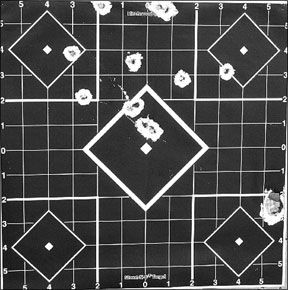
Unlike many wingshooting versions of the Model 37, the Ithaca defense model is not a take-down version. It has a solid frame with the barrel permanently threaded into its all-steel receiver similar to that employed by the Ithaca Deerslayer II and III. It is a very strong system, as solid threads are obviously stronger than interrupted threads of the same length. By virtue of the bottom-loading and bottom-eject action, the M37 goes a long way toward being ambidextrous. The trigger-guard safety is set up for the right-handed shooter, but is reversible if you desire. The M37 is chambered for 2.75-inch and 3-inch shells, and is cylinder bore. The receiver is machined from an 8-pound block of steel, and its barrel is made of 4140 chrome-moly. Despite the Ithaca’s robust, all-steel construction, it was the lightest gun tested.
At the range, we couldn’t have been happier with the Ithaca’s performance. We made a lot of hulls, in sets of eight at a time, using factory Remington STS loads, and a variety of our heavier reloads for function testing. We had no malfunctions of any kind, and our testers said the factory Pachmayr pad did a fine job of attenuating the recoil, and hull ejection was both positive and forceful. The Ithaca’s action was by far the smoothest and slickest action of the tested guns.
Our Team Said: The Ithaca Model 37 was the best-built, smoothest, best-balanced shotgun in the test. It also had the best trigger, and it was fastest and most user-friendly to operate. It is easy to load and shoot quickly, easy to point quickly, has impressive eight-shot firepower and is pleasant to shoot despite its comparatively spritely weight. Also, it costs $200 less than the others. The Ithaca wins big on both performance and price.
Remington Model 870 Tac-2 FS No. 81402 3-inch 12 Gauge, $692
The Remington Tactical with its Knoxx SpecOps pistol-grip folding stock weighed in at about 8.1 pounds. The 870’s forearm is black plastic, and the external metal parts are finished in black oxide. Its trigger broke at a reasonable 5.25 pounds. The Model 870 Tac-2 folding stock has sling-swivel studs installed on a clamp at the front of the magazine tube and at the folding-stock hinge area. This Remington features an 18-inch barrel (chambered for 2.75- and 3-inch shells) and has a six-shot magazine capacity due to the supplied and installed two-shot magazine extension. The sight on its plain barrel is a semi-silver bead attached to a dissimilar piece of metal that appears to be glued onto the barrel. The steel receiver is drilled and tapped for a Weaver-rail scope base (not supplied), with filler screws in place.
In short order, our testers found the Knoxx Tac-2 stock to be an ergonomic nightmare. It is nearly 3 inches wide, making a conventional sight picture hard to achieve without mashing the side of the shooter’s face into the left metal rail and canting his head over the stock. Worse yet, the pistol grip at the back of the 870’s receiver makes easy access to the trigger-guard safety arduous. In folded condition, the stock hinges over on top of the shotgun, making it as easy to snag on clothing and other materials in folded condition as it is in the unfolded, locked-open position. The folded condition’s so-called advantage is theoretically an easy way to store this 870. To us, it makes no sense.
Out of the box, the 870 Tactical action exhibited significant stickiness, enough where we could open the action and hold the entire 8 pounds of the gun by the forearm with the action open—and it stayed that way. While most pumps do tend to wear-in and slick-up over time, we felt that this 870’s action was excessively rough out of the box—particularly when compared to the Ithaca’s silky-smooth operation. The stuttering stick-slip of the action persisted. With its shell carrier flap in the way, the 870 felt slow and cumbersome to reload compared to the Ithaca.
Though heavy in weight, this version of the 870 pounded us unmercifully even with 11⁄8-ounce loads—it was horribly unpleasant to shoot. We found this to be in stark contrast to Remington’s shameless ad-brag claiming, “Load them up with even the most potent magnum loads, the Knoxx SpecOps™ stocks are capable of taming even the harshest recoil.”
Our Team Said: Upside—the gun did function okay. But if a hard-to-access safety, snag-o-matic folding stock that fits no one, rough action, slow-loading, overweight, hard-kicking and poor-handling shotgun is a feature set you want for defense, this might be your ticket. We believe that your best personal defense option is avoiding this model of 870.
Mossberg 590A1 No. 51670 3-inch 12 Gauge, $693
The Mossberg 500/590/590A1 special-purpose line has continued to grow to the point where there are some 36 variations of this theme currently available, more if you count the hunting versions. The basic Mossberg 590 pump shotgun is currently in service use by the U.S. Army, U.S. Navy and U.S. Marines. The Mossberg 590 is a more robust version of the familiar 500 series of Mossberg pump-actions that were introduced around 1961. The 590A1 has an aluminum tang safety and trigger guard, a clear upgrade from the more fragile plastic components found on many other versions. Often compared to 870 models, the 590 is considered more ambidextrous due to its tang safety, and easier to load with no shell carrier flap (a.k.a. shell lifter) in the way. Unlike the Ithaca and the Remington’s steel receiver, the Mossberg has an aluminum alloy receiver. As a practical matter, as the Mossberg’s steel bolt locks up to the steel barrel extension, so the alloy receiver it is of no great design consideration for defense applications particularly when considering the 590’s military and LE service records. It may save a few ounces and it is easier to machine, neither of which are considerations here.
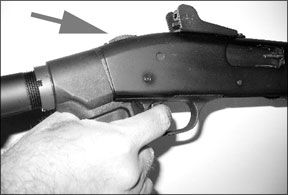
Out of the box, the tested Mossberg 590A1 weighed 7.75 pounds—noticeably lighter than the Remington, but still a full pound heavier than the Ithaca. The Mossberg has the highest capacity of the tested guns at nine shots (8+1). Its stock is detent-adjustable, allowing the shooter to vary the length of pull from 10.5 to 14.25 inches with six different positions. It has a 20-inch heavy-wall barrel that comes fitted from the factory with Mossberg Ghost Ring sights.
After significant initial take-up, the 590’s trigger broke at 7.2 pounds, making it the heaviest trigger in this group. The Mossberg action also exhibited significant stickiness out of the box, as did the Remington, with its action noticeably the sloppiest of the three guns. Though all the rattle from the closed action of the Mossberg is just forearm and action bar slop and take-up, having nothing to do with the locked breech—none of testers liked how noisy and loose it felt and sounded.
When a defense firearm comes with a pistol grip, it is only reasonable to assess how its controls can be accessed (or not) with the gun gripped by its pistol grip. In the case of the Remington, we had a safety that could not be accessed despite its proximity to the grip, and a slide release that could not be reached with the thumb or fingers of the shooter’s dominant hand. With the Mossberg, we had a mixed bag of control access. With the shotgun properly mounted by a right-handed shooter, the thumb of the right hand could easily unlock the slide with a quick flick. When mounted by a left-handed shooter, the left index finger could quickly do the same. However, a left-handed or a right-handed shooter cannot possibly access the tang safety when the shooter is gripping the pistol grip. Though a tang safety is ambidextrous, in this presentation a shooter, regardless of his handedness, cannot use it easily.
As a practical matter, a home-defense firearm by definition needs to be deployed quickly, seamlessly, without conscious effort, and under high-stress and perhaps poorly lit scenarios. The user cannot take the safety off of this shotgun without compromising full control of his shouldered weapon.
The adjustable aluminum stock of the Mossberg was likewise a mixed bag. The threaded tube coming out of the back of the 590’s receiver is aluminum, but the stock itself is plastic. While this plastic stock is easily set to several different pull-lengths, a good feature, it fits over the aluminum tube loosely. At the end of the plastic stock extension, there is a rubber pad that slips over the plastic butt. While offering a small amount of felt recoil reduction, it pales in comparison to a real recoil pad like the Pachmayr found on the Ithaca. The Mossberg’s pad is better than nothing and better than the Remington’s attempt, but not by much.
The Mossberg comes with an adjustable Ghost Ring-sight set-up. We liked the Ghost Ring sight in the general sense, but its utility is compromised in this specific model, we feel. Once the gun is mounted and the shooter has a proper sight picture, pulling the gun more firmly into the shoulder pocket causes the orange-blade front sight to disappear. The culprit is the sloppy plastic stock that bows downward with a slight amount of increased pressure, forcing the muzzle’s orange blade to vanish beneath the Ghost Ring as a result. A variable sight picture is not something we appreciate.
At the range, we appreciated the ability to load the Mossberg’s magazine with no shell carrier to possibly interfere, as is the case with the Ithaca but not the Remington. We also generally liked the adjustable Ghost Ring sights, though their value at the typically very short self-defense ranges is dubious. The standard Mossberg 500/590 platform is fundamentally sound, as the user does not have to break his/her grip, stockweld, or sight picture to use the slide release, safety, and trigger. Adding a pistol grip to the 500/590 disrupts this substantial ease of use, we thought. The catalog description of the 590 A1 #51670 as having a “6 Position Aluminum Adjustable Stock” is more than a little misleading, as we discovered. It is plastic where we come from, and poorly fitted plastic at that. It sorely needs an external locking collar to hold it in position reliably, or a few set-screws.
Our Team Said: The Mossberg in its present form is usable, but we wouldn’t buy it. The stock issues overshadow the things we did like about it, which include ease of loading, magazine capacity, ambidextrous use, and Ghost Ring sights.
0509-Ithaca-Model-37-Defense-Gun.pdf
0509-Remington-Model-870-Tac-2.pdf



























